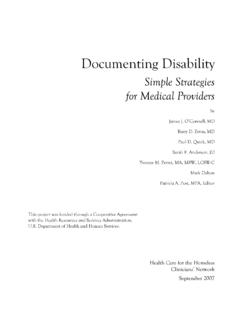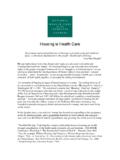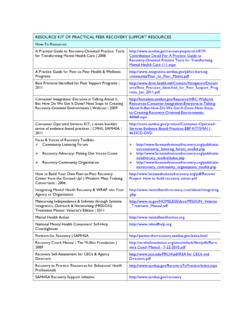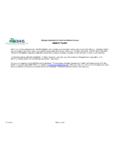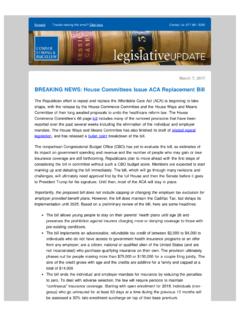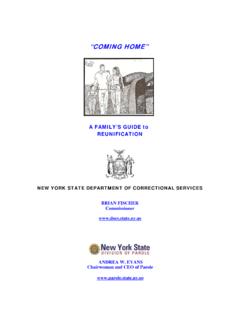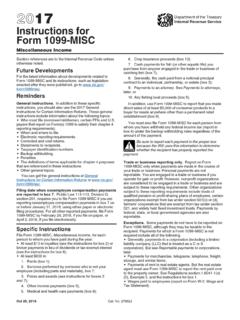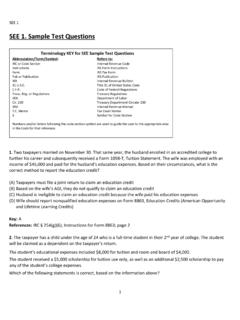Transcription of General Recommendations for the Care of Homeless Patients ...
1 General Recommendations for the Care of Homeless Patients : summary of recommended Practice Adaptations Health Care for the Homeless Clinicians Network ASSESSMENT History Living conditions - Ask where patient is staying. Explore access to food, water, restrooms, place to store medications; exposure to toxins, allergens, infection; threats to health/safety. Be alert to possible homelessness. Prior homelessness - what precipitated it; whether first time, episodic, chronic; history of foster care Acute/ chronic illness - Ask about individual/ familial history of asthma, chronic otitis media, anemia, diabetes, CVD, TB, HIV/ STIs, hospitalizations. Medications Ask about current medications, including psychiatric l contraceptive l OTC meds, dietary supplements, any borrowed medicine prescribed for others.
2 Prior providers including oral health providers; what worked/ didn t work, does patient have regular source of primary care Mental illness/ cognitive deficit - problems with stress, anxiety , appetite, sleep, concentration, mood, speech, memory, thought process and content, suicidal/ homicidal ideation, insight, judgment, impulse control, social interactions; symptoms of brain injury (head aches, seizures, memory loss, lability, irritability, dizziness, insomnia, poor organizational/ decision making skills). Developmental/ behavioral problems - adaptive/maladaptive, underlying pathology Alcohol/nicotine/other drug use - Ask about use (amount, frequency, duration); look for signs of substance abuse/dependence. Health insurance - prescription drug coverage, entitlements (Medicaid/ SCHIP, SSI/ SSDI), other assistance Sexual - gender identity, sexual orientation, behaviors, partners, pregnancies, hepatitis/ HIV/ other STIs History & current risk of abuse - emotional, physical, sexual abuse; knowledge of crisis resources, patient safety Legal problems/ violence - against persons or property, history of arrest/incarceration, treatment while incarcerated Regular/ strenuous activities - consistent routines (treatment feasibility); level of strenuous activity Work history - longest time held a job, veteran status, occupational injuries/ toxic exposures.
3 Vocational skills and interests Education level, literacy Ever in special If trouble reading, , offer help with intake form; assess ability to read English. Nutrition/ hydration - diet, food resources, preparation skills, liquid intake Cultural heritage/ affiliations/ supports - involvement with family, friends, faith community, other sources of support Strengths - coping skills, resourcefulness, abilities, interests Physical examination Comprehensive exam - at 1st encounter if possible: height, weight, BMI, % body fat, abdominal girth, heart, BP, lungs, thyroid, liver, dermatological, oral, fundoscopic, genital, lower extremities Serial, focused exams - for Patients uncomfortable with full-body, unclothed exam at 1st visit Special populations - Victims of abuse, sexual minorities Dental assessment - age appropriate teeth, obvious caries, dental/referred pain, diabetes Patients Diagnostic tests Baseline labs - including, EKG, lipid panel, potassium & creatinine levels, HbA1c, liver function tests Asthma spirometry or peak flow monitoring TB PPD for Patients living in shelters and others at risk for tuberculosis.
4 QuantiFERON -TB Gold test (QFT-G) if available STI screening - for chlamydia, gonorrhea, syphilis, HIV, HBV, HCV, trichomonas, bacterial vaginosis, monilia Mental health - Patient Health Questionnaire (PHQ-9, PHQ-2), MHS-III, MDQ Substance abuse - SSI-AOD Cognitive assessment - Mini-Mental Status Examination (MMSE), Traumatic Brain Injury Questionnaire (TBIQ), Repeatable Battery for the Assessment of Neuro-Psychological Status (RBANS) Developmental assessment - Ages & Stages Questionnaires, Parents Evaluation of Developmental Status (PEDS), Denver II or other standard screening tool Interpersonal violence - Posttraumatic Diagnostic Scale for Use with Extremely Low-income Women Forensic evaluation - if strong evidence of child abuse Health care maintenance - cancer screening for adults, EPSDT for children PLAN & MANAGEMENT Plan of Care Basic needs - Food, clothing, housing may be higher priorities than health care.
5 Patient goals & priorities - immediate/long-term health needs, what patient wants to address first Action plan - simple language, portable pocket card After hours - extended clinic hours, how to contact medical provider when clinic is closed Safety plan - if interpersonal violence/ sexual abuse suspected; mandatory reporting requirements Emergency plan - contacting PCP before going to ER, location of emergency facilities, preparation for evacuation Adherence plan - clarification of care plan/patient feedback; use of interpreter, lay educator if LEP; identification of potential barriers Education, Self-Management Patient/ parent instruction - simple language/illustrations, confirm comprehension; pocket card listing immunizations, chronic illnesses, medications Prevention/ risk reduction - protection from communicable diseases, risk of delayed/ interrupted treatment Behavioral change - individual/small group/community interventions, motivational interviewing Nutrition counseling - diet, dietary supplements, food choices, powdered formula for infants Peer support - support groups, consumer advocates Education of shelter/clinical staff - re: special problems/needs of Homeless people Medications Simple regimen - low pill count, once-daily dosing where possible; capsules/tablets for child > 5 yrs Dispensing - on site; small amounts at a time to promote follow-up, decrease risk of loss theft/ misuse.
6 Avoid written prescriptions when possible. Storage/ access - in clinic/shelters; if no access to refrigeration, don t prescribe meds that require it. Patient assistance - entitlement assistance, free/low-cost drugs if readily available for continued use Aids to adherence - harm reduction, outreach/case management, directly observed therapy Potential for misuse - inhalants, bronchodilators/spacers, pain medications, clonidine, needles Side effects - primary reason for nonadherence (diarrhea, frequent urination, nausea, disorientation) Analgesia/ symptomatic treatment - patient contract, single provider for pain medication refills Immunizations - per standard clinical guidelines; influenza, pneumococcus, HAV, HBV, Td for adults Antibiotics - standard liquid measurements, importance of completing regimen, RSV prophylaxis Dietary supplements - multivitamins with minerals, nutritional supplements with lower resale value Managed care - Prescribe meds that don t require pre-authorization, assistance getting Rx filled Lab monitoring Monitor Patients on antipsychotic medications for metabolic disorders.
7 Associated problems, complications No place to heal - efficacy of medical respite/recuperative care, supportive housing, Fragmented care multiple providers. Use EMR; list prescribed meds on wallet-sized card. Masked symptoms/ misdiagnosis - , weight loss, dementia, edema, lactic acidosis Developmental discrepancies - focus on immediate concerns, not possible future consequences Functional impairments - Document medical and functional impairments;, assist with SSI/SSDI applications; tailor plan of care to patient needs and capacities. Dual diagnoses - integrated treatment for concurrent mental illness/substance use disorders Loss of child custody - support for parent of child abused by others, and for abused parent Follow-up Contact information - phone, e-mail for patient/ friend/ family/ case manager Medical home - to coordinate/promote continuity of health care Frequency - more frequent follow-up, incentives, nonjudgmental care regardless of adherence Drop-in system - Anticipate/ accommodate unscheduled clinic visits.
8 Transportation assistance - Provide carfare, tokens, help with transportation services Outreach, case management - Connect with community outreach programs, HCH providers. Monitor school attendance - Address health/ developmental problems with family/ school. Peer support - client advocate to accompany patient to clinical appointments, ambulatory surgery Referrals - linkage with specialists, pro bono care, providers sensitive to underserved populations MODEL OF CARE Service delivery design Integrated, interdisciplinary - coordinated medical, dental, and psychosocial services Multiple points of service - clinics, drop-in centers, outreach sites; electronic medical records, if feasible Flexible service system - walk-ins permitted, help with resolving systems barriers Access to mainstream health system - ready access to secondary/tertiary care Access to convalescent care/ supported housing medical respite care, permanent housing with supportive services for Patients with serious health conditions Outreach and engagement Outreach sites - streets, soup kitchens, shelters, other Homeless service sites Clinical team - use of outreach workers, case managers, medical providers to promote engagement Therapeutic relationship person-centered, trauma-informed, recovery-oriented, nonjudgmental care based on trust.
9 Frequent encounters Incentives - to promote engagement: food, drink, vouchers, hygiene products, subway/ bus fare (tokens) Standard of care Clinical standards scientific evidence, expert opinion, Recommendations of experienced Homeless services providers. Make elimination of health disparities a clinical goal. Consumer Involvement in peer support, program governance, advocacy, research Integrated service & advocacy to improve service access for Homeless people, address structural causes of homelessness, prevent staff burnout, and facilitate client recovery What Is Homelessness? A Homeless person is .. an individual without permanent housing who may live on the streets; stay in a shelter, mission, single room occupancy facility, abandoned building or vehicle; or in any other unstable or non-permanent situation.
10 An individual may be considered to be Homeless if that person is doubled up, a term that refers to a situation where individuals are unable to maintain their housing situation and are forced to stay with a series of friends and/or extended family members. In addition, previously Homeless individuals who are to be released from a prison or a hospital may be considered Homeless if they do not have a stable housing situation to which they can return. Recognition of the instability of an individual's living arrangement is critical to the definition of homelessness. Principles of Practice: A Clinical Resource Guide for Health Care for the Homeless Programs, Bureau of Primary Health Care/HRSA/HHS, March1999; PAL 99 12. Excerpts from Adapting Your Practice: General Recommendations for the Care of Homeless Patients (2010) Health Care for the Homeless Clinicians Network These and other recommended clinical practice adaptations are available at




